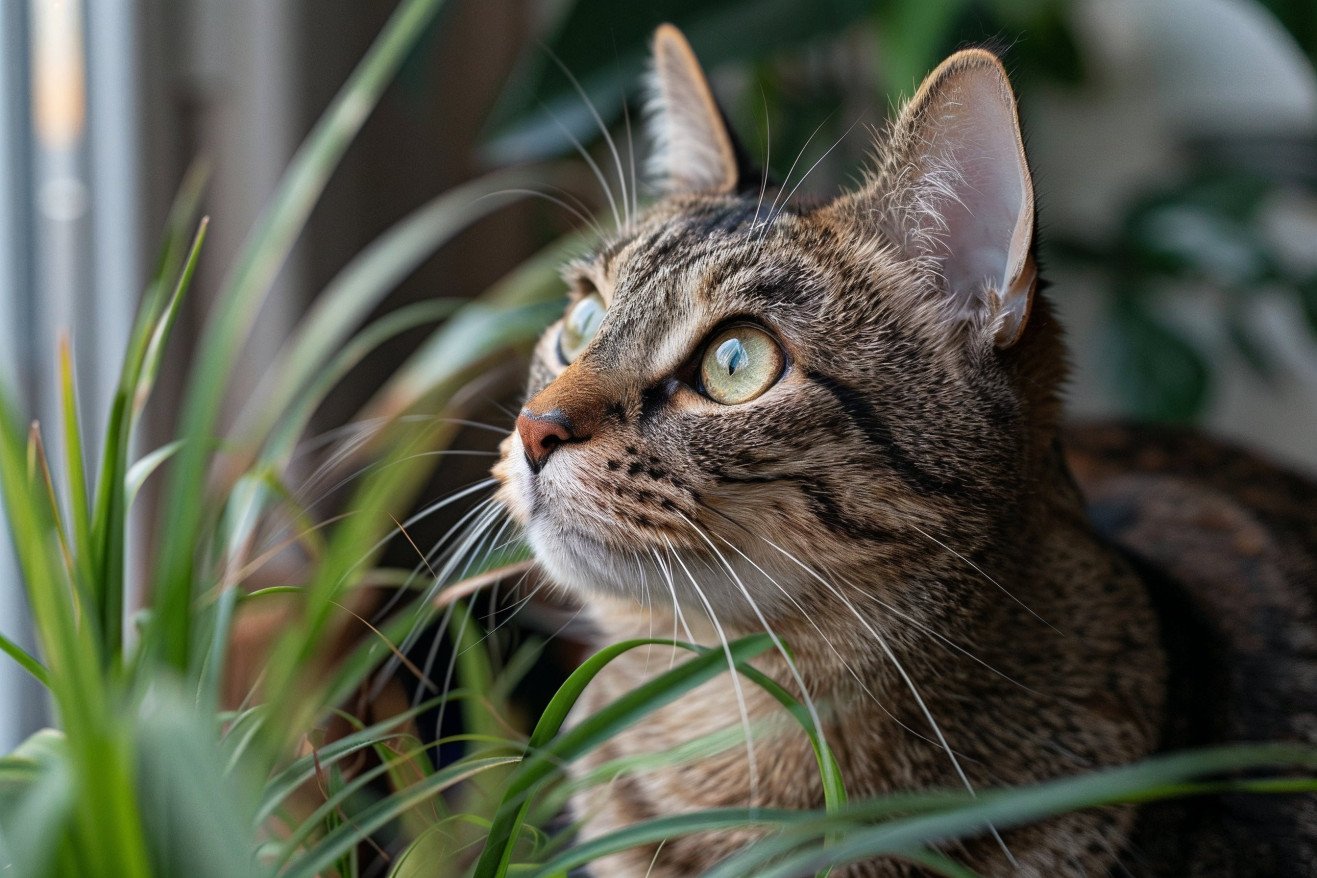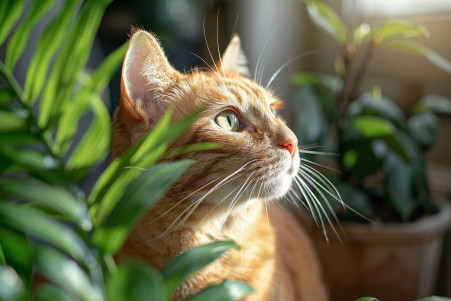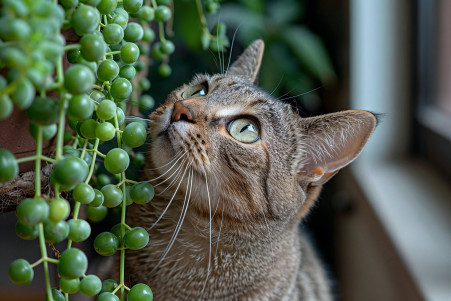Can Ponytail Palms Hurt Cats? What Pet Parents Should Know
5 June 2024 • Updated 3 June 2024

Ponytail palms may look like a fun and tropical addition to your home, but if you have cats, it's important to know about the potential dangers these plants can pose. The ponytail palm is toxic to cats and can cause vomiting, diarrhea, excessive drooling, and lack of appetite if ingested because of the cycasin toxins found in all parts of the plant.
We'll review the latest scientific studies and information from veterinarians to find out exactly what happens when cats eat ponytail palms. You'll also find out how to recognize the symptoms of ponytail palm poisoning in cats, what to do if you suspect your cat has eaten any part of the plant, and how to safely keep ponytail palms in your home if you have cats. Knowing what to expect can help you decide if you want to take the risk of having these plants in your home.
Are ponytail palms toxic to cats?
How to Tell If Your Cat Has Eaten a Ponytail Palm and What Parts Are Toxic?
All parts of the ponytail palm are toxic to cats. The two main toxins are cycasin and saponins, which can cause vomiting, diarrhea, lethargy, and lack of appetite in cats.
Ponytail palms, or Beaucarnea recurvata, are plants with a unique appearance, featuring a swollen, bottle-shaped trunk and long, curved leaves that grow from the top and resemble a ponytail. They can grow up to 10 feet tall when kept indoors. Because of their unique appearance, ponytail palms are easy to recognize as a houseplant.
However, because of the potential danger to cats, it's important to keep ponytail palms in a place where cats can't reach them and won't be tempted to chew on the leaves or trunk. Pet parents can do this by keeping the plant in a room that cats can't access or by using citrus sprays, which cats don't like. If you're handling or repotting a ponytail palm, make sure to wear gloves and wash your hands thoroughly afterward to avoid getting any toxic sap on your skin, where your cat could come into contact with it.
Symptoms of Ponytail Palm Poisoning in Cats
If a cat has eaten any part of the ponytail palm, they may show a variety of symptoms. The ASPCA lists common symptoms as drooling, vomiting, diarrhea, lethargy, and loss of appetite. Symptoms can range in severity from mild stomach upset to more severe and life-threatening issues.
More serious symptoms that require immediate veterinary care include shaking, lack of coordination, and abdominal pain or discomfort, according to a JustAnswer case study. In addition, cats may vomit with a reddish or pinkish tinge, which is a sign of irritation or a small amount of blood from vomiting.
It is important to keep a close eye on a cat that has ingested any part of a ponytail palm. According to PetFoodMark, even if the symptoms are mild, the cat should be taken to the vet because the toxins can lead to liver or kidney issues. Getting medical attention as soon as possible can help prevent more serious problems.
First Aid and Medical Treatment for Ponytail Palm Toxicity
If a cat has eaten any part of a ponytail palm, it is important to take action immediately. Per VCA Animal Hospitals, first aid measures include making sure the cat's airway is clear, giving rescue breaths if necessary, and checking for a heartbeat to see if chest compressions are needed. You should also attempt to make the cat vomit to get rid of any remaining toxins, but only if the cat is awake and alert.
After the cat has been given first aid, it is important to get them to a vet right away, even if they seem to be doing better. The JustAnswer case study explains that if the cat continues to vomit, shake, or show signs of abdominal pain, they need to be seen by a vet immediately.
At the vet's office, the cat may be given supportive treatments like IV fluids, anti-nausea drugs, or activated charcoal to absorb any remaining toxins. In more serious cases, the vet may need to make the cat vomit or perform a gastric lavage to remove the plant material. The cat will also need to be monitored for signs of liver or kidney damage.
Even after the cat has been treated, it is important to continue to monitor them closely. Per the ASPCA, if the toxicity is not treated right away, the cat may experience long-term issues, including organ damage. It is important to stay in contact with the vet to make sure the cat makes a full recovery.
Safety: How to Add Ponytail Palms to Your Pet-Friendly Space
If you want to add a ponytail palm to your home and you have cats, you can take some steps to ensure that your new plant and your pets can peacefully coexist. Plant Decor Shop notes that ponytail palms are less attractive to cats than other houseplants because of their unique shape and succulent leaves. However, the site still recommends repotting the plant in a heavy, stable container "so your cat can't knock it over" to cat-proof it.
The Kitchn recommends placing the ponytail palm in a spot that's out of reach for cats, like a high shelf or a hanging planter. You can also discourage cats from digging in the soil by covering it with materials like tin foil or stones. If your cat does start to show interest in the plant, you can redirect them to a "cat-friendly" plant like cat grass.
Whenever you're introducing a new ponytail palm or a new cat to your home, it's important to supervise the situation closely. Intuitive Plants explains that it may take some trial and error to find the right setup when you're first introducing a ponytail palm to a home with cats, but with the right measures in place, ponytail palms and cats can live together in harmony.
Ponytail Palm Care: How to Help Your Plant Thrive and Stay Safe
As noted by Apartment Therapy, ponytail palms like full sun or bright, indirect light and need nighttime temperatures that don’t drop below 45°F (7°C). While full sun is the best option, these plants are adaptable and will grow more slowly in lower light. Ponytail palms are desert plants, so they don’t need much humidity. However, they shouldn’t be placed near drafts or vents that can dry them out.
Gardening Know How notes that the soil should be allowed to dry out completely between waterings, which generally happens every two weeks (although it can even be once a month). When watering, the soil should be soaked until the water runs out of the bottom of the pot, and then it should be allowed to drain. Overwatering can lead to root rot, while underwatering can cause the leaves and trunk to shrivel.
To keep ponytail palms safe from cats, Indoor Plants recommends using cat deterrents like citrus sprays, planting cat-friendly plants nearby, or hanging the ponytail palm or placing it on a high shelf. Regularly checking the plant for signs of damage and removing any affected leaves can also help ensure that the plant stays healthy and looking its best.
With the proper care and protective measures, ponytail palms can be successfully kept in homes with cats. By making sure that the plant’s needs are met and taking steps to prevent cats from getting into the plant, you can enjoy the tropical beauty of this non-toxic houseplant.
Conclusion: How to Keep Ponytail Palms and Cats Safe
Even though the ASPCA lists ponytail palms as non-toxic to cats, dogs, and horses, ponytail palms can still be dangerous to cats. The leaves, stem, and trunk of the ponytail palm contain saponins and other compounds that can cause vomiting, diarrhea, and lethargy if ingested.
To keep your ponytail palm safe, you can use deterrents like cayenne pepper or citrus scents that cats don't like. You can also place pebbles, pinecones, or aluminum foil on the soil to keep your cat from digging in it. It may also help to provide alternative "sacrificial" plants like catnip or lemon balm to keep your cat from focusing on the ponytail palm.
If your cat does eat any part of the ponytail palm, you should take them to the vet right away. Symptoms like trembling, incoordination, and abdominal pain need to be treated quickly to avoid organ damage. However, with the right precautions and care, you can enjoy the ponytail palm's striking, sculptural appearance in a home with cats.


